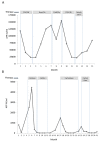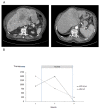Liver cancers with stem/progenitor-cell features - a rare chemotherapy-sensitive malignancy
- PMID: 28938700
- PMCID: PMC5601796
- DOI: 10.18632/oncotarget.19000
Liver cancers with stem/progenitor-cell features - a rare chemotherapy-sensitive malignancy
Abstract
Primary liver tumors are a heterogeneous group of malignancies. Besides classical hepatocellular carcinoma (HCC) and cholangiocarcinoma (CC), combined and intermediate forms of liver cancer exist and can express stem-cell markers like nuclear cell adhesion molecule (NCAM-1/CD56), c-kit (CD117) or epithelial cell adhesion molecule (EpCAM) together with high proliferative activity. Liver tumors with progenitor-cell features are associated with an unfavorable prognosis, but the phenotype has not resulted in therapeutic consequences so far. We report three patients with liver cancers with stem/progenitor-cell features that responded exceptionally well to chemotherapy. These encouraging results indicate that the identification of liver cancer with stem/progenitor-cell phenotype in a patient´s tumor might justify an attempt to treat the patient with chemotherapy. Further case studies and finally clinical trials will be necessary to determine the optimal treatment for patients with this rare form of liver cancer.
Keywords: alpha fetoprotein; chemotherapy; liver cancer; liver progenitor cell; liver stem cell.
Conflict of interest statement
CONFLICTS OF INTEREST There is no conflict of interest.
Figures




References
-
- Llovet JM, Villanueva A, Lachenmayer A, Finn RS. Advances in targeted therapies for hepatocellular carcinoma in the genomic era. Nat Rev Clin Oncol. 2015;12:408–24. - PubMed
-
- Llovet JM, Ricci S, Mazzaferro V, Hilgard P, Gane E, Blanc JF, de Oliveira AC, Santoro A, Raoul JL, Forner A, Schwartz M, Porta C, Zeuzem S, et al. SHARP Investigators Study Group Sorafenib in advanced hepatocellular carcinoma. N Engl J Med. 2008;359:378–90. - PubMed
-
- Valle J, Wasan H, Palmer DH, Cunningham D, Anthoney A, Maraveyas A, Madhusudan S, Iveson T, Hughes S, Pereira SP, Roughton M, Bridgewater J, ABC-02 Trial Investigators Cisplatin plus gemcitabine versus gemcitabine for biliary tract cancer. N Engl J Med. 2010;362:1273–81. - PubMed
-
- Sia D, Villanueva A, Friedman SL, Llovet JM. Liver Cancer Cell of Origin, Molecular Class, and Effects on Patient Prognosis. Gastroenterology. 2017;152:745–61. - PubMed
-
- Bosman FT, Carneiro F, Hruban RH, Theise ND, editors. WHO classification of Tumors of the Digestive System. 4th ed. IARC Press; 2010.
LinkOut - more resources
Full Text Sources
Other Literature Sources
Research Materials
Miscellaneous

